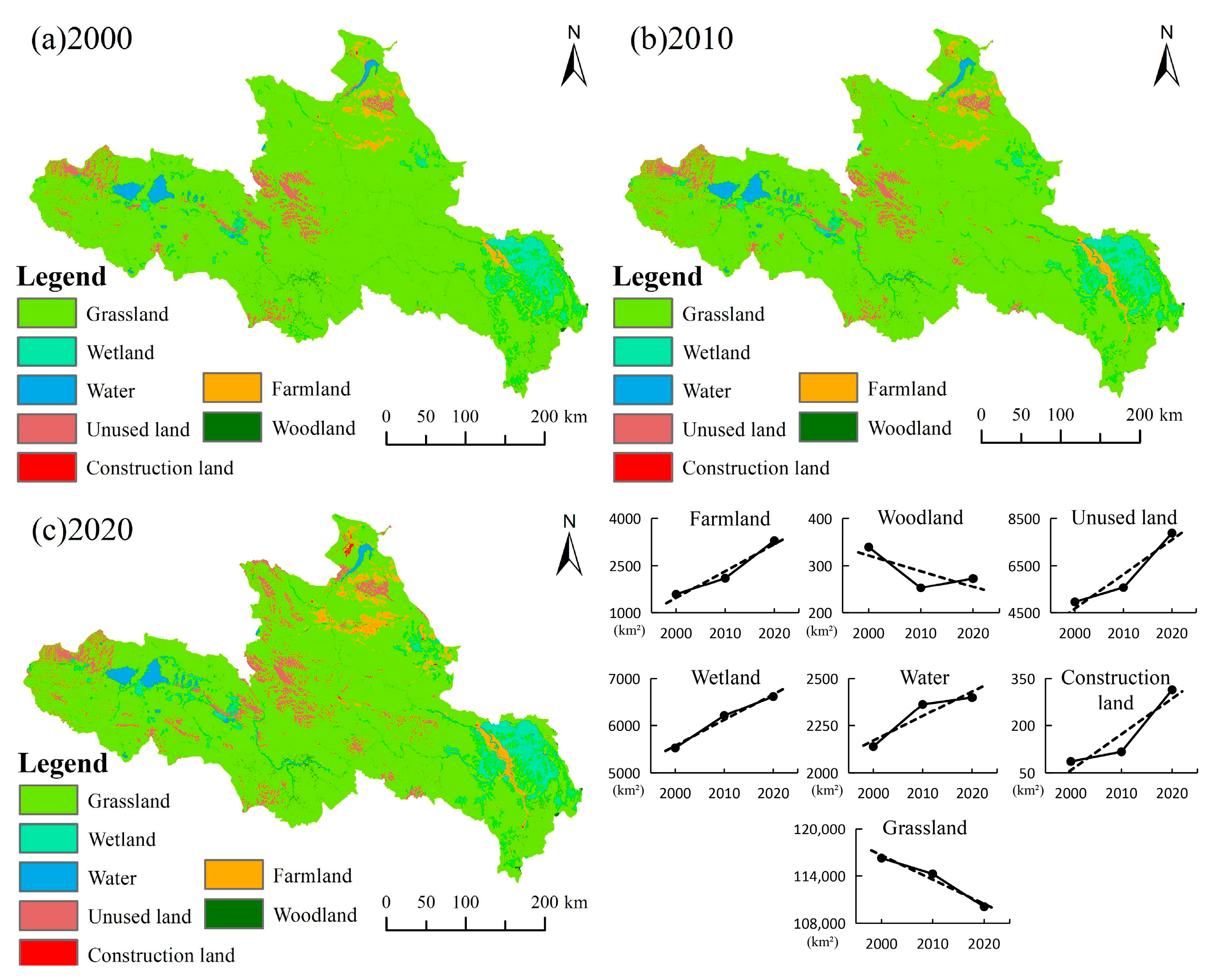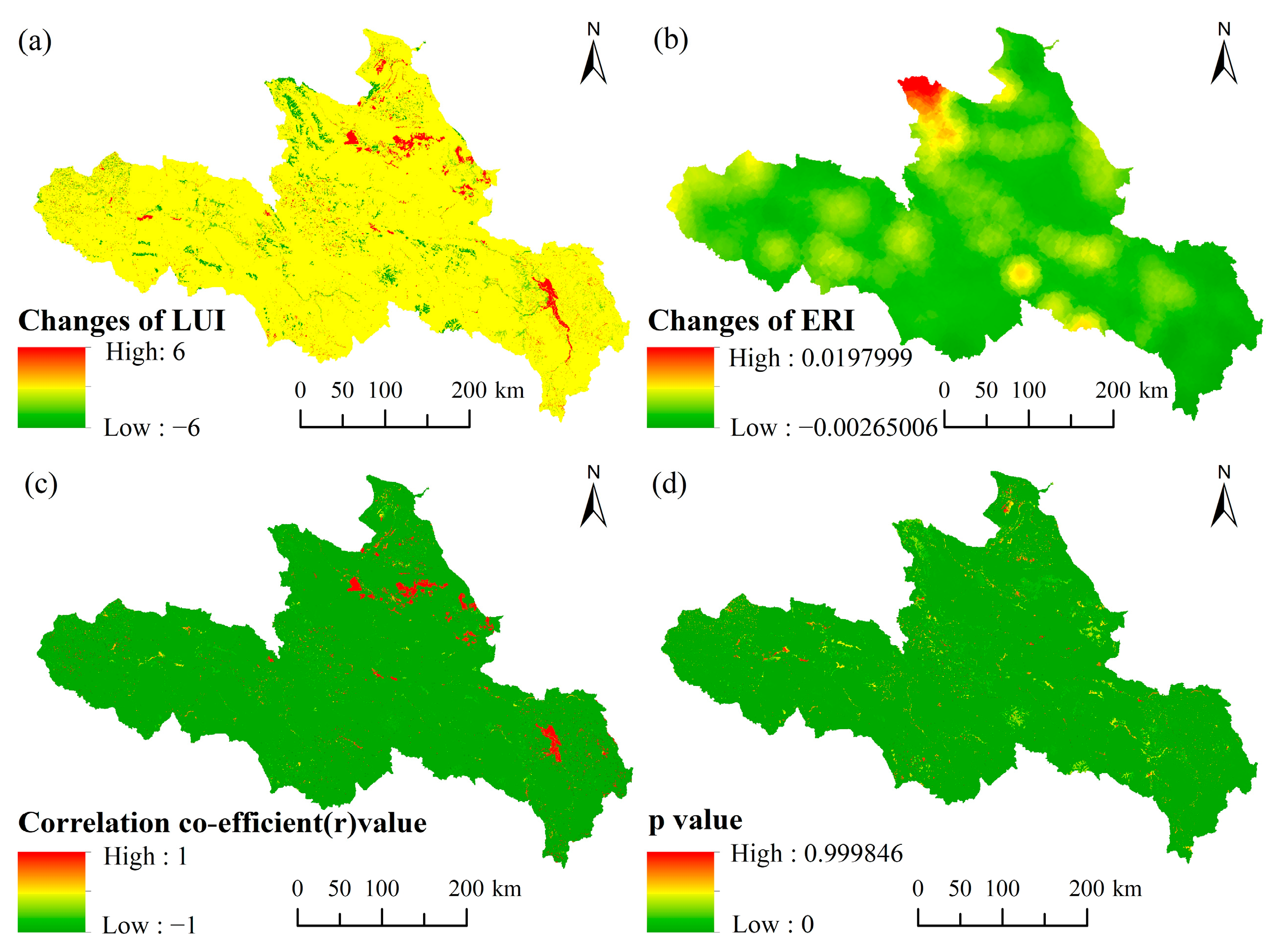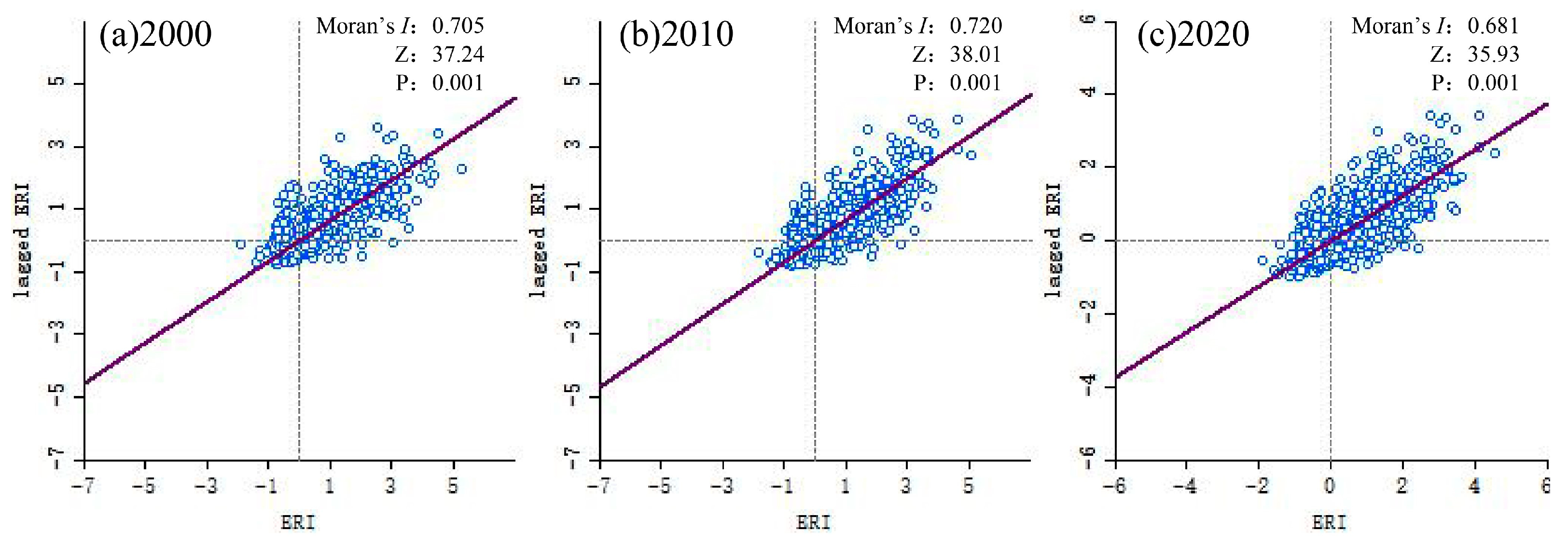Evolution of Landscape Ecological Risk and Identification of Critical Areas in the Yellow River Source Area Based on LUCC
Abstract
1. Introduction
2. Materials and Methods
2.1. Study Area
2.2. Data Sources
2.3. Land Use Transfer Matrix Model
2.4. Division of Evaluation Unit
2.5. Landscape Ecological Risk Index Evaluation
2.6. Regional Ecological Risk Analysis
2.7. Exploratory Spatial Data Analysis
2.8. Pearson Correlation Analysis
3. Results and Analysis
3.1. Land Use Changes
3.2. Changes in Ecological Risk in the Landscape
3.3. Local Spatial Auto-Correlation Analysis
4. Discussion
5. Conclusions
Author Contributions
Funding
Institutional Review Board Statement
Informed Consent Statement
Data Availability Statement
Acknowledgments
Conflicts of Interest
References
- He, G.; Ruan, J. Study on ecological security evaluation of Anhui Province based on normal cloud model. Environ. Sci. Pollut. Res. 2022, 29, 16549–16562. [Google Scholar] [CrossRef] [PubMed]
- Calow, P. Ecological risk assessment: Risk for what? How do we decide? Ecotoxicol. Environ. Saf. 1998, 40, 15–18. [Google Scholar] [CrossRef]
- van Loon-Steensma, J.M.; Goldsworthy, C. The application of an environmental performance framework for climate adaptation innovations on two nature-based adaptations. Ambio 2022, 51, 569–585. [Google Scholar] [CrossRef]
- Peng, J.; Dang, W.; Liu, Y.; Zong, M.; Hu, X. Review on landscape ecological risk assessment. Acta Geogr. Sin. 2015, 70, 664–677. [Google Scholar]
- Wu, L.Y. The Study of Regional Landscape Ecological Risk Assessment and the Environmental Risk Management Countermeasure: Take Dongshan Island for Example; Fujian Normal University: Fuzhou, China, 2004. [Google Scholar]
- Lawrence, A.K. Using landscape ecology to focus ecological risk assessment and guide risk management decision-making. Toxicol. Ind. Health 2001, 17, 236–246. [Google Scholar]
- Wang, G.; Cheng, G.; Qian, J. Several problems in ecological security assessment research. J. Appl. Ecol. 2003, 14, 1551–1556. [Google Scholar]
- Suter, G.W., II. Ecological Risk Assessment; CRC Press: Boca Raton, FL, USA, 2016. [Google Scholar]
- Li, L.; Fassnacht, F.E.; Bürgi, M. Using a landscape ecological perspective to analyze regime shifts in social–ecological systems: A case study on grassland degradation of the Tibetan Plateau. Landsc. Ecol. 2021, 36, 2277–2293. [Google Scholar] [CrossRef]
- Sahraoui, Y.; Leski, C.D.G.; Benot, M.-L.; Revers, F.; Salles, D.; van Halder, I.; Barneix, M.; Carassou, L. Integrating ecological networks modelling in a participatory approach for assessing impacts of planning scenarios on landscape connectivity. Landsc. Urban Plan. 2021, 209, 104039. [Google Scholar] [CrossRef]
- Zhang, F.; Yushanjiang, A.; Wang, D. Ecological risk assessment due to land use/cover changes (LUCC) in Jinghe County, Xinjiang, China from 1990 to 2014 based on landscape patterns and spatial statistics. Environ. Earth Sci. 2018, 77, 491. [Google Scholar] [CrossRef]
- De Montis, A.; Caschili, S.; Mulas, M.; Modica, G.; Ganciu, A.; Bardi, A.; Ledda, A.; Dessena, L.; Laudari, L.; Fichera, C.R. Urban–rural ecological networks for landscape planning. Land Use Policy 2016, 50, 312–327. [Google Scholar] [CrossRef]
- Zhang, W.; Chang, W.J.; Zhu, Z.C.; Hui, Z. Landscape ecological risk assessment of Chinese coastal cities based on land use change. Appl. Geogr. 2020, 117, 102174. [Google Scholar] [CrossRef]
- Xie, H.; Wen, J.; Chen, Q.; Wu, Q. Evaluating the landscape ecological risk based on GIS: A case-study in the poyang lake region of China. Land Degrad. Dev. 2021, 32, 2762–2774. [Google Scholar] [CrossRef]
- Liu, Y.; Liu, Y.; Li, J.; Lu, W.; Wei, X.; Sun, C. Evolution of landscape ecological risk at the optimal scale: A case study of the open coastal wetlands in Jiangsu, China. Int. J. Environ. Res. Public Health 2018, 15, 1691. [Google Scholar] [CrossRef]
- Ji, Y.; Bai, Z.; Hui, J. Landscape ecological risk assessment based on LUCC—A case study of Chaoyang county, China. Forests 2021, 12, 1157. [Google Scholar] [CrossRef]
- Wang, H.; Liu, X.; Zhao, C.; Chang, Y.; Liu, Y.; Zang, F. Spatial-temporal pattern analysis of landscape ecological risk assessment based on land use/land cover change in Baishuijiang National nature reserve in Gansu Province, China. Ecol. Indic. 2021, 124, 107454. [Google Scholar] [CrossRef]
- Ai, J.; Yu, K.; Zeng, Z.; Yang, L.; Liu, Y.; Liu, J. Assessing the dynamic landscape ecological risk and its driving forces in an island city based on optimal spatial scales: Haitan Island, China. Ecol. Indic. 2022, 137, 108771. [Google Scholar] [CrossRef]
- Li, C.; Zhang, J.; Philbin, S.P.; Yang, X.; Dong, Z.; Hong, J.; Ballesteros-Pérez, P. Evaluating the impact of highway construction projects on landscape ecological risks in high altitude plateaus. Sci. Rep. 2022, 12, 5170. [Google Scholar] [CrossRef] [PubMed]
- Yu, T.; Bao, A.; Xu, W.; Guo, H.; Jiang, L.; Zheng, G.; Yuan, Y.; Nzabarinda, V. Exploring variability in landscape ecological risk and quantifying its driving factors in the Amu Darya Delta. Int. J. Environ. Res. Public Health 2020, 17, 79. [Google Scholar] [CrossRef] [PubMed]
- Wu, L.; Liu, X.; Yang, Z.; Chen, J.; Ma, X. Landscape scaling of different land-use types, geomorphological styles, vegetation regionalizations, and geographical zonings differs spatial erosion patterns in a large-scale ecological restoration watershed. Environ. Sci. Pollut. Res. 2021, 28, 38374–38392. [Google Scholar] [CrossRef]
- Xia, M.; Jia, K.; Zhao, W.; Liu, S.; Wei, X.; Wang, B. Spatio-temporal changes of ecological vulnerability across the Qinghai-Tibetan Plateau. Ecol. Indic. 2021, 123, 107274. [Google Scholar] [CrossRef]
- Zhang, S.; Zhao, K.; Ji, S.; Guo, Y.; Wu, F.; Liu, J.; Xie, F. Evolution characteristics, eco-environmental response and influencing factors of production-living-ecological space in the Qinghai–Tibet Plateau. Land 2022, 11, 1020. [Google Scholar] [CrossRef]
- Wang, S.; Wei, Y. Qinghai-tibetan plateau greening and human well-being improving: The role of ecological policies. Sustainability 2022, 14, 1652. [Google Scholar] [CrossRef]
- Cai, H.; Yang, X.; Xu, X. Human-induced grassland degradation/restoration in the central Tibetan Plateau: The effects of ecological protection and restoration projects. Ecol. Eng. 2015, 83, 112–119. [Google Scholar] [CrossRef]
- Jun, C.; Ban, Y.; Li, S. Open access to Earth land-cover map. Nature 2014, 514, 434. [Google Scholar] [CrossRef]
- GB/T 21010-2017; Current Land Use Classification. General Administration of Quality Supervision, Inspection and Quarantine of the People’s Republic of China. China National Standardization Administration: Beijing, China, 2017.
- Zhang, H.; Wang, Z.; Chai, J. Land use\cover change and influencing factors inside the urban development boundary of different level cities: A case study in Hubei Province, China. Heliyon 2022, 8, e10408. [Google Scholar] [CrossRef]
- Hu, Y.; Zhen, L.; Zhuang, D. Assessment of land-use and land-cover change in Guangxi, China. Sci. Rep. 2019, 9, 2189. [Google Scholar] [CrossRef] [PubMed]
- GB/T 12409-2009; Geographic Grid. General Administration of Quality Supervision, Inspection and Quarantine of the People’s Republic of China. China National Standardization Administration: Beijing, China, 2009.
- Chen, X.; Xie, G.; Zhang, J. Landscape ecological risk assessment of land use changes in the coastal area of Haikou City in the past 30 years. Acta Ecol. Sin. 2021, 41, 975–986. [Google Scholar]
- Du, J.; Zhao, S.; Qiu, S.; Guo, L. Land Use Change and Landscape Ecological Risk Assessment in Loess Hilly Region of Western Henan Province from 2000 to 2015. Res. Soil Water Conserv. 2021, 28, 279–284+291. [Google Scholar]
- Jin, X.; Jin, Y.; Mao, X. Ecological risk assessment of cities on the Tibetan Plateau based on land use/land cover changes–Case study of Delingha City. Ecol. Indic. 2019, 101, 185–191. [Google Scholar] [CrossRef]
- Kang, Z.; Zhang, Z.; Wei, H.; Liu, L.; Ning, S.; Zhao, G.; Wang, T.; Tian, H. Landscape ecological risk assessment in Manas River Basin based on land use change. Acta Ecol. Sin. 2020, 40, 6472–6485. [Google Scholar]
- Yang, L.; Deng, M.; Wang, J.; Jue, H. Spatial-temporal evolution of land use and ecological risk in Dongting Lake Basin during 1980–2018. Acta Ecol. Sin. 2021, 41, 3929. [Google Scholar]
- Shen, Z.; Zeng, J. Spatial relationship of urban development to land surface temperature in three cities of southern Fujian. Acta Geogr. Sin. 2021, 76, 566–583. [Google Scholar]
- Qiu, B.; Wang, Q.; Chen, C.; Chi, T. Spatial Autocorr elation Analysis of Multi-scale Land Use in Fujian Province. J. Nat. Resour. 2007, 22, 311–321. [Google Scholar]
- Cohen, I.; Huang, Y.; Chen, J.; Benesty, J.; Benesty, J.; Chen, J.; Huang, Y.; Cohen, I. Pearson correlation coefficient. In Noise Reduction in Speech Processing; Springer: Berlin/Heidelberg, Germany, 2009; pp. 1–4. [Google Scholar]
- Hoque, M.Z.; Islam, I.; Ahmed, M.; Hasan, S.S.; Prodhan, F.A. Spatio-temporal changes of land use land cover and ecosystem service values in coastal Bangladesh. Egypt. J. Remote Sens. Space Sci. 2022, 25, 173–180. [Google Scholar]
- Fu, B.; Ouyang, Z.; Shi, P.; Fan, J.; Wang, X.; Zheng, H.; Zhao, W.; Wu, F. Current Condition and Protection Strategies of Qinghai-Tibet Plateau Ecological Security Barrier. China Acad. J. Electron. Publ. House 2021, 36, 1298–1306. [Google Scholar]
- Xue, J.; Li, Z.; Feng, Q.; Gui, J.; Zhang, B. Spatiotemporal variations of water conservation and its influencing factors in ecological barrier region, Qinghai-Tibet Plateau. J. Hydrol. Reg. Stud. 2022, 42, 101164. [Google Scholar] [CrossRef]
- Zhao, Y.; Chen, D.; Fan, J. Sustainable development problems and countermeasures: A case study of the Qinghai-Tibet Plateau. Geogr. Sustain. 2020, 1, 275–283. [Google Scholar] [CrossRef]
- Hu, Y.; Maskey, S.; Uhlenbrook, S. Trends in temperature and rainfall extremes in the Yellow River source region, China. Clim. Change 2012, 110, 403–429. [Google Scholar] [CrossRef]
- Ni, Y.; Lv, X.; Yu, Z.; Wang, J.; Ma, L.; Zhang, Q. Intra-annual variation in the attribution of runoff evolution in the Yellow River source area. Catena 2023, 225, 107032. [Google Scholar] [CrossRef]
- Qin, Y.; Yang, D.; Gao, B.; Wang, T.; Chen, J.; Chen, Y.; Wang, Y.; Zheng, G. Impacts of climate warming on the frozen ground and eco-hydrology in the Yellow River source region, China. Sci. Total Environ. 2017, 605, 830–841. [Google Scholar] [CrossRef]
- Tian, H.; Lan, Y.; Wen, J.; Jin, H.; Wang, C.; Wang, X.; Kang, Y. Evidence for a recent warming and wetting in the source area of the Yellow River (SAYR) and its hydrological impacts. J. Geogr. Sci. 2015, 25, 643–668. [Google Scholar] [CrossRef]
- Pan, T.; Wu, S.; Liu, Y. Relative contributions of land use and climate change to water supply variations over yellow river source area in Tibetan plateau during the past three decades. PLoS ONE 2015, 10, e0123793. [Google Scholar] [CrossRef]
- Guo, B.; Wei, C.; Yu, Y.; Liu, Y.; Li, J.; Meng, C.; Cai, Y. The dominant influencing factors of desertification changes in the source region of Yellow River: Climate change or human activity? Sci. Total Environ. 2022, 813, 152512. [Google Scholar] [CrossRef]
- Rong, T.; Long, L.H. Quantitative Assessment of NPP Changes in the Yellow River Source Area from 2001 to 2017. IOP Conf. Ser. Earth Environ. Sci. 2021, 687, 012002. [Google Scholar] [CrossRef]
- Zhang, X.; Nian, L.; Liu, X.; Li, X.; Adingo, S.; Liu, X.; Wang, Q.; Yang, Y.; Zhang, M.; Hui, C. Spatial–Temporal Correlations between Soil pH and NPP of Grassland Ecosystems in the Yellow River Source Area, China. Int. J. Environ. Res. Public Health 2022, 19, 8852. [Google Scholar] [CrossRef] [PubMed]
- Liu, J.; Chen, J.; Qin, Q.; You, H.; Han, X.; Zhou, G. Patch pattern and ecological risk assessment of alpine grassland in the source region of the Yellow River. Remote Sens. 2020, 12, 3460. [Google Scholar] [CrossRef]
- McDaniels, T.; Axelrod, L.J.; Slovic, P. Characterizing perception of ecological risk. Risk Anal. 1995, 15, 575–588. [Google Scholar] [CrossRef] [PubMed]
- Jin, H.; He, R.; Cheng, G.; Wu, Q.; Wang, S.; Lü, L.; Chang, X. Changes in frozen ground in the Source Area of the Yellow River on the Qinghai–Tibet Plateau, China, and their eco-environmental impacts. Environ. Res. Lett. 2009, 4, 045206. [Google Scholar] [CrossRef]
- Wu, T.; Hou, X.; Xu, X. Spatio-temporal characteristics of the mainland coastline utilization degree over the last 70 years in China. Ocean Coast. Manag. 2014, 98, 150–157. [Google Scholar] [CrossRef]
- Du, L.; Dong, C.; Kang, X.; Qian, X.; Gu, L. Spatiotemporal evolution of land cover changes and landscape ecological risk assessment in the Yellow River Basin, 2015–2020. J. Environ. Manag. 2023, 332, 117149. [Google Scholar] [CrossRef]
- Lu, Z.; Song, Q.; Zhao, J.; Wang, S. Prediction and Evaluation of Ecosystem Service Value Based on Land Use of the Yellow River Source Area. Sustainability 2022, 15, 687. [Google Scholar] [CrossRef]








| Macro LULC Classes | Micro LULC Classes Information | Level of Intensity |
|---|---|---|
| Construction land | Surface formed by man-made construction activities, including various residential areas, industrial mines, and transportation facilities in towns. | 7 |
| Farmland | Land used for growing crops, including paddy fields, dry land, vegetable fields, pastureland, orchards. | 6 |
| Woodland | The land is covered by trees with crown coverage over 30% and the land covered by shrubs with shrub coverage over 30% are forest, shrub land, open forest land, and immature forest land. | 5 |
| Grassland | The land covered by natural herbaceous vegetation with coverage higher than 10% includes grassland, meadow, savanna, and desert grassland. | 4 |
| Wetland | Land with shallow water or over-wet soil, including inland marshes, lake marshes, and shrub wetlands. | 3 |
| Water | Liquid water covered areas and ice-covered areas, including rivers, lakes, glaciers, and beaches. | 2 |
| Unused land | Naturally covered land with less than 10% vegetation cover, including saline, sandy, bare rock, and bare tundra. | 1 |
| Index | Symbol | Formula |
|---|---|---|
| Landscape fragmentation | In the formula, is the number of patches of landscape type , is the area of landscape type . | |
| Landscape Separation | , In the formula, is the distance index of landscape type , is the total area of landscape type | |
| Landscape fractal dimension | In the formula, is the perimeter of the landscape type | |
| Landscape disturbance degree | In the formula, a, b, and c are the weights of the corresponding landscape indices, and + + = 1 | |
| Landscape Vulnerability | The vulnerability index of each landscape type itself after normalization after scoring by experts are farmland, 0.14, woodland, 0.07, grassland, 0.11, wetland, 0.18, water, 0.21, construction land, 0.04, and unused land, 0.25 | |
| Landscape loss degree |
Disclaimer/Publisher’s Note: The statements, opinions and data contained in all publications are solely those of the individual author(s) and contributor(s) and not of MDPI and/or the editor(s). MDPI and/or the editor(s) disclaim responsibility for any injury to people or property resulting from any ideas, methods, instructions or products referred to in the content. |
© 2023 by the authors. Licensee MDPI, Basel, Switzerland. This article is an open access article distributed under the terms and conditions of the Creative Commons Attribution (CC BY) license (https://creativecommons.org/licenses/by/4.0/).
Share and Cite
Lu, Z.; Song, Q.; Zhao, J. Evolution of Landscape Ecological Risk and Identification of Critical Areas in the Yellow River Source Area Based on LUCC. Sustainability 2023, 15, 9749. https://doi.org/10.3390/su15129749
Lu Z, Song Q, Zhao J. Evolution of Landscape Ecological Risk and Identification of Critical Areas in the Yellow River Source Area Based on LUCC. Sustainability. 2023; 15(12):9749. https://doi.org/10.3390/su15129749
Chicago/Turabian StyleLu, Zhibo, Qian Song, and Jianyun Zhao. 2023. "Evolution of Landscape Ecological Risk and Identification of Critical Areas in the Yellow River Source Area Based on LUCC" Sustainability 15, no. 12: 9749. https://doi.org/10.3390/su15129749
APA StyleLu, Z., Song, Q., & Zhao, J. (2023). Evolution of Landscape Ecological Risk and Identification of Critical Areas in the Yellow River Source Area Based on LUCC. Sustainability, 15(12), 9749. https://doi.org/10.3390/su15129749






